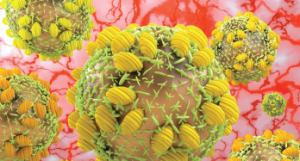
fotovapl/shutterstock.com
CHICAGO—Leonard H. Calabrese, DO, professor of medicine at Cleveland Clinic in Ohio, presented on emerging concepts of viral infections and rheumatic disease at the ACR’s State-of-the-Art Clinical Symposium in April. “We are at a pivotal point in rheumatology in understanding the relationship between viruses and rheumatic disease,” began Dr. Calabrese. “It’s a very exciting time.” Dr. Calabrese then discussed hepatitis C (HCV) and hepatitis B viruses (HBV) and their association with rheumatic disease in more detail.
HCV & Rheumatic Disease
Dr. Calabrese described HCV as “a deaccelerating infection.” Although there are 200 million individuals worldwide infected with the virus, he believes that, with the advent of direct-acting anti-virals (DAA), it will soon be possible to abolish HCV infections. DAA treatment is associated with cure rates of 95–100%. Treatment protocols can be as brief as six weeks, causing Dr. Calabrese to enthuse, “This is a curable disease—within a few months. … It’s a whole new deal.”
DAAs have not only changed the medical landscape for patients with HCV, but have also led to the question: How quickly does their immune deficit recover? Unfortunately, according to Dr. Calabrese, there appears to be a long delay.
HCV infection increases the risk for several rheumatologic diseases, but patients who are infected with HCV are most at risk for cryoglobulinemic vasculitis, which manifests with palpable purpura, arthralgia and weakness.
A study presented at the 2016 ACR/ARHP Annual Meeting examined the effect of DAAs on HCV cryoglobulinemic vasculitis.1 It included 35 patients who were prescribed sofosbuvir and daclatasvir. The patients achieved 100% sustained virologic response (SVR) and had a 91% complete clinical response at 12 weeks. However, at 12 weeks, only 50% of patients had a complete immunologic response. These findings build on results from previous studies, which also demonstrated either failure to clear cryoglobulinemic vasculitis or a relapse of cryoglobulinemic vasculitis that appeared independent of virologic relapse.
The 2015 ACR screening recommendations for HCV remain unchanged from the 2008 recommendations.2 The guidelines suggest screening those at risk for HCV infection only prior to treatment with methotrexate/leflunomide. Dr. Calabrese counters, however, that HCV as a comorbidity for rheumatic disease now serves as an opportunity to bring HCV-infected patients into a circle of care.
The treatment goal for a patient who is positive for HCV is to first cure the HCV infection and then manage the autoimmune diseases traditionally. Thus, rheumatologists should screen for HCV, and if the patient tests positive, refer them to a good hepatologist for treatment. If the patient does not respond to DAA, then alternative and older treatment strategies apply.
These older strategies indicate that rheumatologists should treat patients with HCV and mixed cryoglobulinemia with rituximab. As of 2011, 150 published cases of HCV-mixed cryoglobulinemia treated with rituximab had been published. These studies have not found any evidence of increased risk of liver toxicity, although they have found that HCV viral load may increase in patients treated with rituximab. As of 2012, several studies have suggested that rituximab may be associated with flares of HCV in the context of combined chemotherapy and in the treatment of cryoglobulinemia with advanced liver disease.3,4
HBV & Rheumatic Disease
Global immunization has led to the deceleration of HBV infection. Nevertheless, HBV infects 400 million–500 million individuals worldwide, and there are 1.25 million chronic cases in the U.S. Although HBV is a de-emerging pathogenic cause of rheumatic disease, changes in epidemiology and drug therapy make HBV reactivation a major concern. Extrahepatic complications of HBV include arthralgia, arthritis, arthritis dermatitis, polyarteritis nodosa (PAN), nephropathy and aplastic anemia.
Immunosuppression can lead to HBV reactivation, but unlike with HCV, the major risk of reactivation of HBV is not during, but rather following immunosuppression. Reactivation can then lead to severe and even fatal hepatitis. Researchers have described this phenomenon in patients with rheumatoid arthritis (RA) as well as other conditions that have required a patient who is positive for HBV infection to be treated with conventional or biologic therapy.
Dr. Calabrese proposed what he considered to be a reasonable strategy to treat patients who are positive for HBV infection and also require immunosuppression. He began by stating that rheumatologists should screen all patients from other countries to determine if they are HBV positive. The screening tests should include tests for hepatitis B surface antigen (HBsAg), antibody to hepatitis B core antigen (anti-HBc) and antibody to hepatitis B surface antigen (anti-HBsAb). In addition, all patients who will begin immunosuppressive therapy should be screened first for HBV infection. Any patient who screens positive by serological test should then be tested for the presence of HBV-DNA. Preemptive therapy should be initiated in all HbsAg-positive and HBV-DNA-positive patients. Patients who have an isolated anti-HBc positive test should be carefully monitored. Rheumatologists should refer all patients who are potential candidates for anti-viral therapy to hepatology.
Dr. Calabrese concluded his presentation by saying there is an intimate relationship between human viral infections and rheumatic disease in terms of etiology, comorbidity and complications. The relationship is not simple and is often combinatorial. Rheumatologists must, therefore, stay informed on clinical and basic research in this area in order to improve the diagnosis, management and prevention of disease.
Lara C. Pullen, PhD, is a medical writer based in the Chicago area.
References
- Saadoun D, Ferfar Y, Bouyer AS, et al. Sofosbuvir plus daclatasvir for hepatitis C virus associated cryoglobulinemia vasculitis (abstract 17L). Arthritis Rheumatol. 2016;68(suppl 10). 17L.
- Singh JA, Saag KG, Bridges SL Jr., et al. 2015 American College of Rheumatology Guideline for the Treatment of Rheumatoid Arthritis. Arthritis Rheum. 2016 Jan;68(1):1–26.
- Pietrograndea M, De Vitab S, Zignego AL, et al. Recommendations for the management of mixed cryoglobulinemia syndrome in hepatitis C virus-infected patients. Autoimmun Rev. 2011 Jun;10(8):444–454.
- Mahale P, Kontoyiannis DP, Chemaly RF, et al. Acute exacerbation and reactivation of chronic hepatitis C virus infection in cancer patients. J Hepatol. 2012 Dec:57(6):1177–1185.
